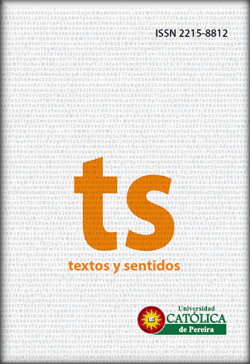Youth and ICT: a look from everyday life
Keywords:
Youth, Digital Native, Digital Immigrant, ICT useAbstract
The active participation of young people in the use of ICTmakes them to be attached to the category of “digital natives”.On the opposite bank, there are the “digital immigrants” foruse both as age. In this new scenario, an objective arisesaiming to characterize the relationships that a group ofyoung students has with ICT in their everyday life in the cityof Pereira. This research supports the conclusion that nightand home time and space are young preferred for the use ofICT, who are not experts in the managing of all applicationsand sometimes require technological assistance from the socalled “immigrants.” This allows the debate about importedtheories and the naturalization of the same in our context,and thus to contribute to the discovery of the actual use ofICT in everyday life for these young people.
References
Aries, P. (1990). El niño y la vida familiar en el antiguo régimen. Madrid: Taurus.
Balardini, S. (2009). De los jóvenes, la juventud y las políticas de juventud. Conferencia pronunciada en el Seminario “Políticas locales de juventud”, Concepción, Chile.
Bañon, A. (2010). Las nuevas tecnologías y la comunicación de jóvenes y adolescentes, usos y discursos. Interacções, 16.
Battro, A. y Denham, P. (1997). La educación digital. Buenos Aires: Emecé.
Bennett, S., Maton, K. y Kervin, L. (2009). Inmigrantes y nativos digitales: problemas de un estereotipo. Recuperado de http://weblogs.clarin.com/economedia/
Bernete, F. (2010). Usos de las TIC, relaciones sociales y cambios en la socialización de las y los jóvenes. Revista de Estudios de juventud, 88
Cassany D. y Ayala G. (2008). Estudios e investigaciones, Nativos e inmigrantes digitales en la escuela. CEE Participación Educativa.
Cordova, V. (1993). La historia de vida. Un método de investigación. Disponible en http://diariodelosandes.com/content/view/19246/78930
Feixa, C. (1998). De jóvenes, bandas y tribus. Antropología de la juventud. Barcelona: Ariel.
Galvis, A. (2004). Oportunidades educativas de las TIC. En: Metacursos soluciones elerning innovadoras. Bogotá.
Geertz, C. (1992). Descripción densa. Hacia una teoría interpretativa de la cultura. En: La Interpretación de las culturas. Barcelona:Gedisa.
Gillis, J. (1981). Youth anh history. Tradition and change in European age. New York: Academic Press.
Margulis, M. y Urresti, M. (1998). La construcción social de la condición de juventud. Bogotá: Universidad Central DIUC.
Musgrove, F. (1965). Youth and the Social Order. Blominston: Indiana University Press.
Orellana, D. (2009). La vida Cotidiana. Revista Universitaria de investigación y diálogo académico, 5(2).
Piscitelli, A. (2009). Nativos digitales. Dieta cognitiva, inteligencia colectiva y arquitecturas de la participación. Buenos Aires: Santillana, Aula XXI.
Pollio, H ., Henley, T & Thompson, C. (2006). The phenomenology of everyday-life. England: Cambridge University.
Prensky, M. (2001). Nativos Digitales, Inmigrantes Digitales. On the Horizon MCB University Press, 9(6).
Prieto, A. (2007). Grupos focales. Centro nacional de excelencia tecnológica en salud.México: Secretaria de Salud.
Medios Milenium (2010). En 2010 se acelerará la revolución digital en Colombia. Disponible en http://www.mediosmilenium.com/sala-de-prensa/15-noticias-/130-en- 2010-se- acelerara-la-revolución-digital-en-Colombia
Ministerio de las Tecnologías de la Comunicación y la Información (2010). Informe trimestral de conectividad. Disponible en http://www.mintic.gov.co
Ministerio de las Tecnologías de la Comunicación y la Información (2011). Ley 1341 de 2009. Disponible en http://www.mintic.gov.co/adm_history_mintic.asp
Unión Internacional de Telecomunicaciones (2010). El mundo en 2010: Hechos y cifras de las TIC. Disponible en http://www.itu.int/net/itunews/issues/2010/10/04-es. aspx.

